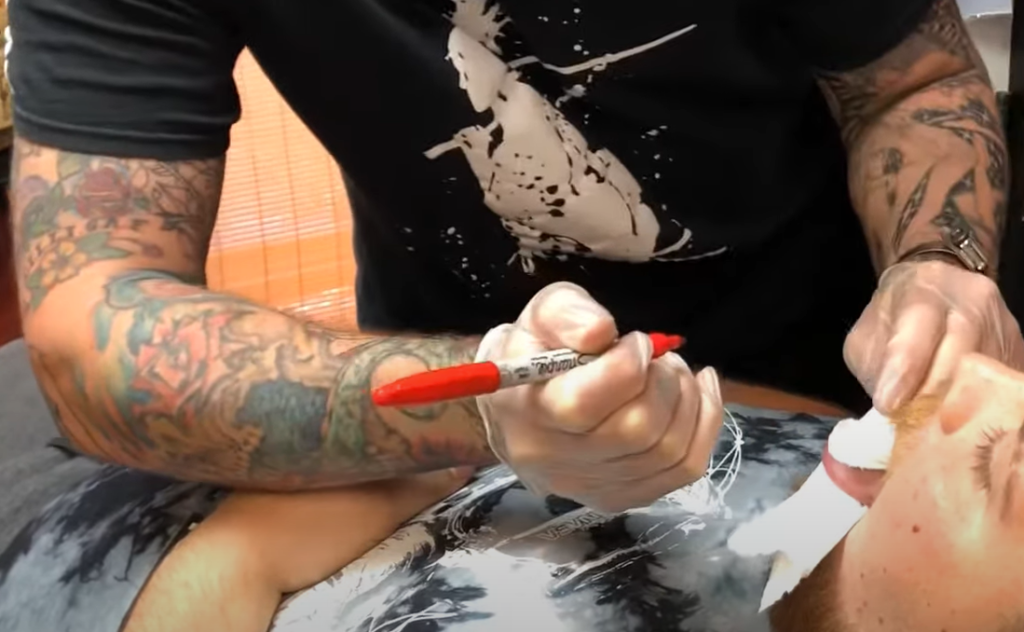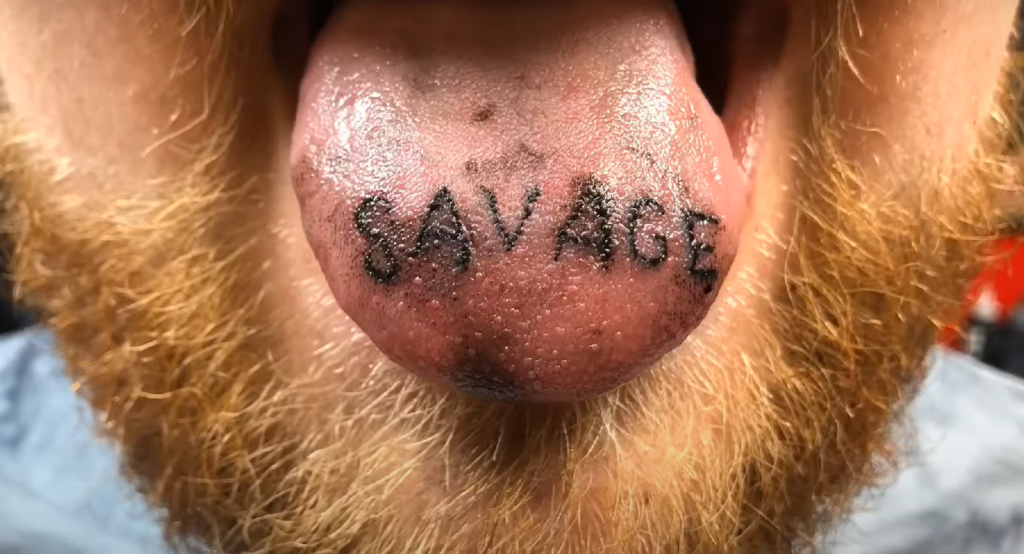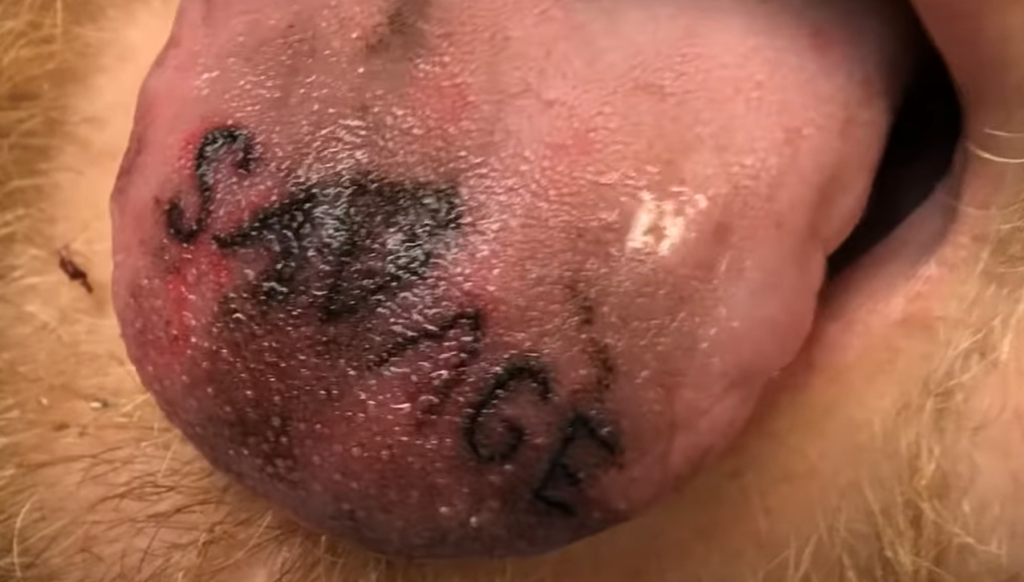Ink lovers are always looking for new and innovative ways to express themselves. And what could be more unique than getting a tattoo on your tongue? It’s the perfect way to show off your personality and style! But is it safe? Can you tattoo your tongue? In this article, we will explore the risks and benefits of getting a tongue tattoo. We’ll also answer some common questions about this type of ink. So read on to learn everything you need to know before making this permanent decision!
Are tongue tattoos safe?
There are a few risks associated with tongue tattoos. The most serious complication is infection. Because the tongue is a muscle, it is constantly moving and rubbing against your teeth. This can cause the tattoo to become irritated and lead to an infection. Tongue tattoos can also lead to swelling and pain in the area. In some cases, the swelling can be so severe that it interferes with breathing. There is also a risk of allergic reactions to the ink or other materials used in the tattooing process. And finally, there is always the possibility of regretting your decision down the road! [1]
These days it is already difficult to think of parts of the body where there can be no tattoo.
Getting complex tattoos on the tongue is almost impossible, because the tattoo does not last very long (from two weeks to a year), and in general, the tongue is not the most ideal surface for a tattoo, so take care to find a good tattoo artist.
There is a modern method of applying tattoos on the tongue with the addition of fragrances to the ink, with the disappearance of the tattoo, the fragrance is consumed along with the tattoo. You can choose from chocolate, vanilla or garlic flavors.
The history of tongue tattooing can be traced back to Hawaii in the 1820s, when a missionary named William Ellis witnessed the tattooing of Queen Kamamalu’s tongue. [2]
The procedure for tattooing by an artist is the same as that used in most tongue piercing procedures. The rest is pretty much the same as any other tattoo procedure.

The features that need to be taken into account are taste buds, epithelial papillae, which, if damaged, can distort food tastes, from the appearance of a permanent taste in the mouth to the complete loss of taste from food.
In terms of pain level, the tongue is one of the least painful parts to get tattooed. Many describe their sensations from “tickling”, numbness to “bitten tongue”. Although the tongue may have sensitive nerve endings, it is also the strongest muscle in the body.
In terms of healing time, on average, it takes three weeks and during the first few days you may feel pain from the procedure.
Do tongue tattoos hurt?
The pain associated with tongue tattoos varies from person to person. Some people report feeling only a minor discomfort, while others compare the sensation to getting a piercing. The pain also depends on the location of the tattoo. The inside of the mouth is full of nerve endings, so tattoos placed in this area are usually more painful. If you’re concerned about pain, talk to your artist about numbing options before getting inked. [3]
Are tongue tattoos permanent?
Tongue tattoos are considered semi-permanent because they will eventually fade over time. The rate at which they fade depends on several factors, such as how often you use your tongue, what foods you eat, and how well you take care of your ink. In general, though, you can expect your tongue tattoo to last for several years before it starts to fade. [4]
How long does it take for a tongue tattoo to heal?
During this time, you will need to take special care of your ink. Avoid eating spicy or acidic foods, as they can irritate the healing tattoo. You should also avoid drinking alcohol or smoking, as these habits can delay healing. Once your tattoo has healed, you can return to your normal diet and lifestyle!If you’re considering getting a tongue tattoo, be sure to do your research and choose a reputable artist. Tongue tattoos are a big commitment, so be sure you’re ready to make this permanent decision!
How do I care for my tongue tattoo?
Tongue tattoos are a bit more difficult to care for than regular tattoos. You need to be extra careful not to irritate or infect the area. Here are some tips on how to care for your tongue tattoo:
- Rinse your mouth with warm water after eating;
- Avoid spicy, hot, or acidic foods that can aggravate the area;
- Gently brush your teeth twice a day with a soft toothbrush;
- Use alcohol-free mouthwash to rinse your mouth several times a day.
If you experience any redness, swelling, or pain in the tattooed area, see your doctor or dentist right away.

Tongue tattoos are becoming more and more popular, but they are still a bit of a mystery to many people. If you’re thinking about getting a tongue tattoo, it’s important to do your research and make sure you understand the risks involved.
How long does a tongue tattoo last?
Tongue tattoos usually last between one and five years. The ink is constantly being ingested and broken down by the body, so it doesn’t stay in the skin for very long. If you want your tattoo to last longer, you’ll need to touch it up every few years.
If you’re considering a tongue tattoo, make sure you find a reputable artist who has experience doing them. Tongue tattoos are not like regular tattoos, so they require a bit of extra care and attention. But if you’re willing to put in the work, they can be a fun and unique way to express yourself! [5]
Tongue Tattoo Designs
If you’re looking for ideas for your tongue tattoo, check out these popular designs:
- Tribal patterns;
- Stars;
- Hearts;
- Initials or words in a foreign language;
- Logos or symbols of your favorite sports team, band, or brand.
The main requirement is the simplicity of the drawing. Maybe a tattoo in Arabic. Its symbols look stylish but are not difficult to execute. A short saying can easily fit on the muscle of the mouth. You can speak without making a sound.
If you want an artistic picture, for example, webs are suitable. Their clear lines will not blur longer. The graphic drawing is easy for perception and execution by the master. There may also be a spider on the web. Separate images of insects are also used. It seems that a real cockroach, ant, or beetle has crawled into the mouth.
From pretty symbols, flowers are transferred to languages. Tattoos in Spanish are preferred to be supplemented with carnations.
In the oral cavity, buds of saturated tones look advantageous. The tongue, unlike the skin, is not beige. On the scarlet surface, only some colors are clearly visible. To the place blue forget-me-nots, purple bells, orange marigolds.
What determines the price of a tattoo?
Many people who want to get a tattoo are concerned about the issue of cost. There is an opinion that the only factor that affects the price of a tattoo is its size. But this is far from true. The tattoo artist does not measure drawings with a matchbox or other objects.

The calculation of the cost is made at the sight of an accurate picture, when you can fully evaluate the picture. Let’s figure out what the price of a future tattoo is made up of.
Complexity of implementation
This is perhaps one of the main factors affecting the price of a tattoo. It is the complexity of the sketch that determines the time spent by the master on the tattoo, and the number of sessions.
The complexity of the execution is determined only by the master himself, since the ideas of an ordinary person about the simplicity or complexity of a drawing may not always be correct.
Even a small tattoo can cost more than a larger one if the sketch contains a lot of small details and colors.
Covering an old tattoo with a new one is also considered a rather laborious process.
Size
While size isn’t the only deciding factor, it does matter.
In order to indicate the size to the master, measure the same place on the body and tell the size in centimeters. If you bring a life-size finished sketch, then it will be even easier.
Remember that specifics are important here, and not comparisons of a picture with a pack of cigarettes or a matchbox.
Originality of the tattoo
The exclusivity of the tattoo is also important. Having come to the master, you can see a catalog with ready-made sketches, or find a ready-made drawing for a tattoo on the Internet.
This option is somewhat cheaper than making an individual sketch exclusively for you. In order to prepare a sketch, the master may take several days, and this already increases the cost of the tattoo.
Place of application
There are places on the human body where the work of the master is difficult and does not go as quickly and easily as on others. For example, it is much more difficult to fill a pattern on the neck, stomach or ribs than on the back or shoulder. Therefore, there is still some influence of place on the cost.
Tattoos in multiple sessions
Obviously, especially complex and large tattoos may require several trips to the master. Naturally, this will take more effort, time and money, both from the master and from you.

Well, now you know that the cost of a tattoo is estimated by the master separately in each case and takes into account many factors.
Do tongue tattoos disappear?
The answer to this question is a resounding maybe. While some people report that their tongue tattoo has faded significantly over time, others say theirs has remained largely the same. It really depends on how well your body tolerates the ink and whether you take good care of your tattoo.
This isn’t necessarily a bad thing, as it can give your tattoo a more subtle look that may be more appropriate for certain situations. Just be sure to discuss your expectations with your artist before getting inked![6]FAQ
Can you tattoo your eyes?
Eyeball tattooing is, strictly speaking, not really a tattoo. It is rather an injection – a needle is inserted into the sclera and through a syringe, the tattoo artist fills the eyeball with colored ink. That is, it is almost impossible to “draw” before the eyes, you can only mix colors on the entire space of the sclera, creating the desired visual effect. Male and female tattoos on the eyeball are no different, except perhaps in colors, but there is no clear separation: men can choose juicy multi-colored options, and women can choose an eerie black fill.
The eyeball tattoo procedure looks quite intimidating. That’s what the master does:
- first instills an anesthetic drug;
- then injects the pigment into the iris or sclera with the finest needle;
- removes the needle, erases the remnants of paint.
You won’t be able to do it at once – you need at least three procedures. The wizard works sequentially, filling the top, middle and bottom layers of the shell. All this time the client is under the supervision of the master. The body does not always accept a tattoo on the eyeball. If the pigment is distributed unevenly or the edema persists for a long time, the master will recommend to postpone the continuation or completely abandon the idea.
In addition, tattooing the eyeballs threatens with complications. The reasons are a significant risk of infection, as well as dyes, none of which has been tested and has not been patented specifically for this procedure. There is a danger of allergies, inflammation and retinal detachment. The most dangerous possible consequences include the following:
- development of glaucoma, cataracts;
- infection of the pupil – closure with fibrous tissue;
- photophobia, increased tearing;
- partial or complete blindness. [7]
What tattoos last the longest?
There is no definitive answer to this question as everyone’s body reacts differently to tattoo ink. That being said, certain inks are known to be more durable than others. For example, black and white tattoos tend to last longer than color tattoos. Additionally, tattoos located on areas with less movement (such as the chest or back) often stay put better than those on areas that see a lot of action (like the wrists or ankles).
If you’re looking for a tattoo that will stand the test of time, it’s important to do your research and find an experienced artist who uses high-quality inks. With proper care, your tattoo should last for many years to come!
Where do tattoos age the best?
This is another question without a definitive answer, as everyone’s skin ages differently. However, certain areas of the body are generally considered to be better for tattoos than others. For example, the chest and back are often said to be good spots for tattoos that you want to age well. This is because these areas don’t see as much movement or exposure to the elements as other parts of the body (like the hands or feet).
The tattoo will stay with you for many years, so you should choose a design that is least likely to annoy you after a while. Therefore, before engraving a sketch on the skin, try to periodically look at it for some time – let it stay in front of your eyes for a while so that you understand if such a print bothers you. By the way, we have already said that tattoos on the legs and body are less likely to annoy you, because you look at them much less often.
Another important factor is the durability of the ink, which also varies by location. So, it is better to choose the area of the skin that is most convenient to cover – the ink fades faster under open exposure to sunlight. The collarbones, the inner side of the arms, the back, the neck, which is easy to cover with hair, the shoulders and calves are best suited in this case – these areas are the least susceptible to aging.

Be especially careful with color tattoos – such works are most sensitive to bright light. Remember that in the abdomen, on the folds of the joints and palms, which are most exposed to water, as well as on the legs and other places that are constantly rubbing against clothes, you should be more careful with designs.
For large designs, choose large areas of skin and places that will be easy for the master to reach – the back, hips or shoulder. But small tattoos look best on small fragments of skin. Do not forget that this also affects the price of the issue – large tattoos can cost significantly more.
Useful Video: Tattooed tongue
Conclusion
In conclusion, while it may be possible to tattoo your tongue, there are many risks associated with the procedure that should be considered before making a decision. If you’re still interested in getting a tongue tattoo after reading this post, please do your research and talk to a qualified professional before going ahead with the procedure.
References:
- https://www.healthline.com/health/body-modification/tongue-tattoo
- http://www.coffeetimes.com/tattoos.htm
- https://www.tattoodo.com/articles/lets-talk-about-tongue-tattoos-4257
- https://people.howstuffworks.com/culture-traditions/body-art/do-tongue-tattoos-affect-taste.htm
- https://www.interviewarea.com/frequently-asked-questions/can-u-tattoo-your-tongue
- https://beautymasterasia.com/en/thinking-about-a-tongue-tattoo-youll-want-to-consider-a-few-things-first/
- https://www.health.nsw.gov.au/environment/factsheets/Pages/eyeball-tattooing.aspx











Leave a Review